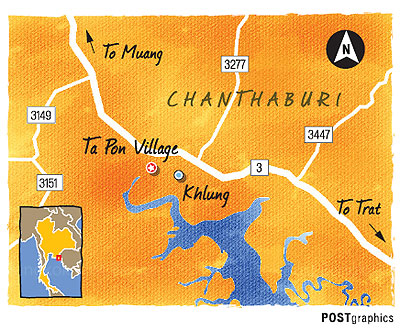The small community in the Tapon village of Chanthaburi has just celebrated its annual Hae Phrabat festival — an interesting and unique event that is likely to draw attention from nationwide and even international visitors in the coming years.

Night prayers around sand sculptures in Wat Tapon Yai.
Hae Phrabat, which translates literally as a celebration of Buddha’s footprints, is co-organised by several temples in the community on the third and fourth week of April. Instead of the staple parades, dancing performances and lots of loud music, however, the community celebrates this Thai event with a tug of war.
“The ceremony was started more than 150 years ago,” explains Kan Koranee, 65, president of the Cultural Council of Khlung district and board member of the Cultural Council of Chanthaburi.

A tug of war is of the annual ceremony.
Its origins can be traced to a time when the village was suffering from a major cholera outbreak that caused huge numbers of people to die. As panic filled the air, and as a bit to keep people calm, the monks of Tabon Noi temple decided to bring out a highly respected cloth painting of four individual Buddha footprints to bless the people. The holy cloth, which people call “phra”, is believed to date back to the Ayutthaya period, 1582AD. Back then the holy cloth was carried around on a cart from one community to the other in the sub-district of Tapon.
“People came out of their houses to pray while many joined the procession. When the parade passed a house with sick people, it stopped to allow them to touch the holy cloth,” he said.
Villagers survived the outbreak and Kan recalls a story from the community that during the procession, there was also heavy rains that “helped cleanse the disease".
Ever since that day, locals from the Tapon community repeat the procession every year in order to be blessed. As there were six villages, but only one holy cloth to go around, a solution was quickly found, which involved a tug of war. The winning team had the first chance to host a merit-making ceremony in their community.
No one is permitted to see the footprints on the holy cloth today as the temple committee of Wat Tapon Noi has decided to keep it folded in order to preserve the painting.
Kan, who says he saw the inscription when he was a Buddhist novice, said the holy cloth contains a small footprint in the centre, representing the present Gautama Buddha, with three larger-size footprints circled around it, representing three Buddhas before him. There are also paintings of angles around the footprints to represent guardians. There is no record about the size of each footprint. The holy cloth is about 2.5m in width and 10.5m in length.
He said the holy cloth remains in the prayer hall of Wat Tabon Noi and only the replica is used for the annual ceremony. Nowadays though, even the replica is off limits and is displayed folded and wrapped with a saffron robe; tied firmly with a holy white thread from top to bottom.
To officially start the ceremony of Hae Phrabat on April 14, locals put the replica of the holy cloth on top of a wooden cart and parade it around the different villages (around 9km). The tug of war tournament took place from April 15-30.
The largest event is hosted in Wat Tabon Yai. During the afternoon of April 17, villagers around Wat Tabon Yai and nearby communities gathered in the temple to play or watch the tug of war.
Rope is attached on both sides of the wooden cart and then placed in the middle of two teams, comprised of 10 men on each side. Before the game starts, each player must kneel down and wai to pay respect to the holy cloth. A man sits on the cart and bangs a drum. Each time the drum is hit, the teams try to drag the cart to their side in order to win.
Apart from the male competition, there is also a housewife category, elderly against guests category and a childrens’ category (below the age of 10).
“We believe that anyone participating in this Hae Phrabat ceremony will be blessed,” Kan said.
Another large part of the festival comes after the tug of war, when locals compete in creating sand sculptures. Sand is placed in the middle of the temple ground, with two-feet wide, square-shape bamboo markers denoting separate sections.
Many teams build the sculptures to resemble a stupa, a pyramid, a Buddha head, or even an aeroplane, bearing a message in memorial of missing Malayasia Airlines flight MH370. T
his year, there was even one sculpture representing two cartoon characters from the Line app.
In the evening, the temple turned off the lights and people lit up the candles on each sand sculpture while the monks chanted. The celebration ended with a temple fair and singing and dancing contests.
“I hope our festival lives on,” said Kan, adding that it was of paramount importance that it did as it was a unique celebration that could be found only in Chanthaburi.

Flower peacocks and fresh flowers are used for decorations.


